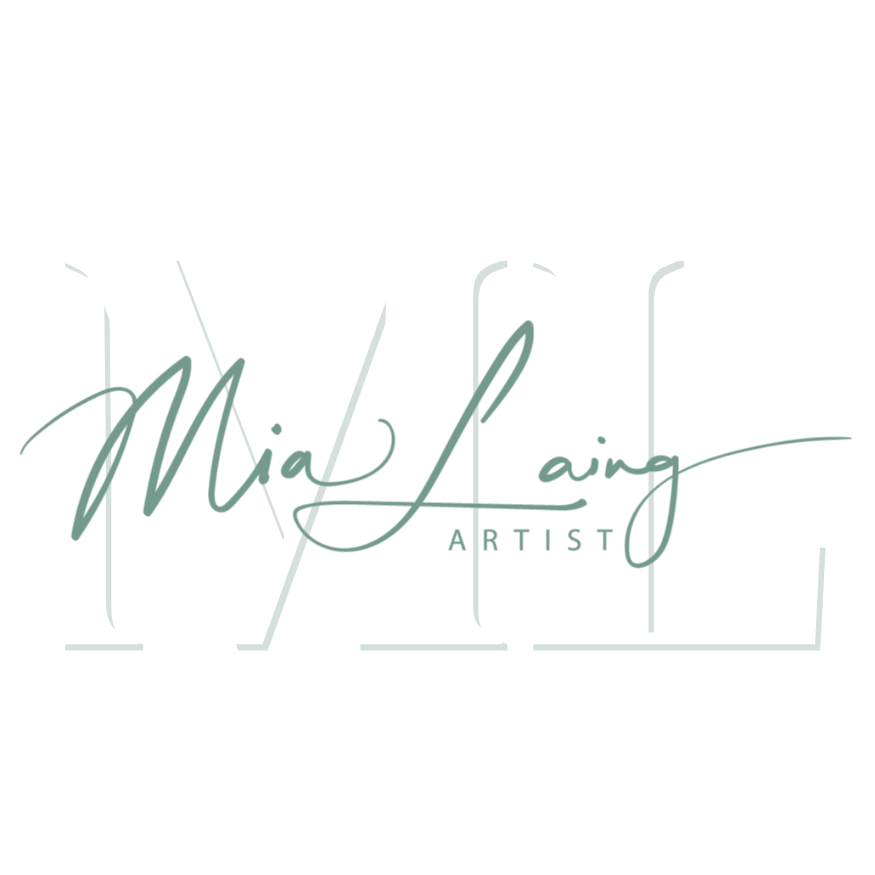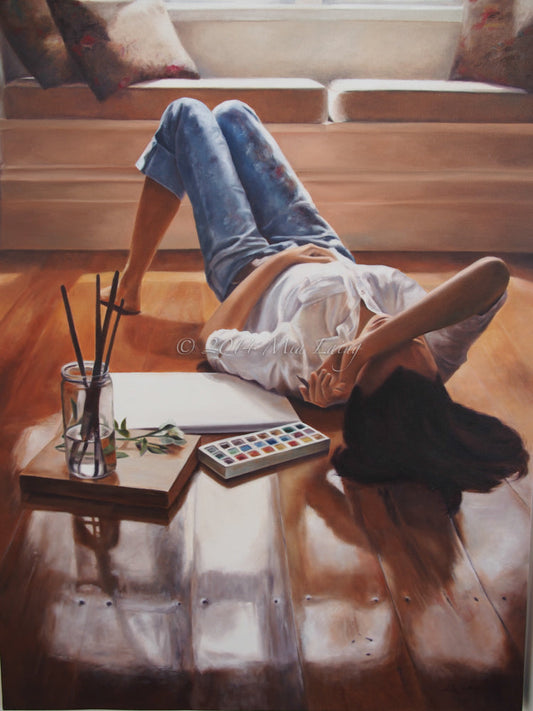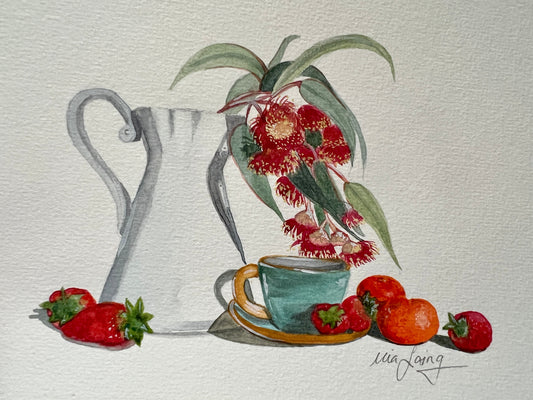
'Cascade' Oil On canvas, Mia Laing 152x91cm
Cascade is without doubt my favourite painting (so far!) this year, not just because of its whimsy and verve, but for the struggle and push that followed me through the whole paint process.
“Huh? Struggle is fun?” I hear you ask. “Have you completely lost your turps riddled mind?”
Let me explain...and for a start, though I’m an oil painter, my studio is nearly always solvent free, so turps is actually not a part of my crazy brain. Remind me to do a blog post on this one day. The turps that is...my brain is unexplainable.
The Oil Paint Process Behind The Making of Cascade
Staring at a large blank canvas can be a very daunting experience, especially when you have an idea that’s completely unresolved and is barely more than a thumbnail sketch on a scrap of paper. So the first thing I do with all my paintings, is to get a layer of colour onto the canvas, effectively blocking out all that white! I would normally have a bit of a plan to how I want to step out the paint process, but I started Cascade on a whim and it remained unresolved until nearly the last few brush strokes of its completion.
I noticed a photograph of some roses one day on Unsplash and saved it for its glorious colour palette and for possible use in a future still life painting. After a few days of pondering and scribbling down ideas for other paintings, I kept coming back to the roses and their strong colours and how they could be used within a wildlife painting.

Reference photo by Unsplash
I’d seen a few peacocks on my meanderings around Pinterest but knew I did not want to tackle all those feathers, so I had dismissed the peacock idea...until 2.30am, when all small ideas become major brainwaves.
I had a big canvas already in my studio and by mid morning had gessoed and drawn up the empty silhouette of my life sized peacock. Taking the bunch of roses that had caught my eye, I drew them as a 'blob' form into the body of the peacock. As there were only a small selection of roses in the reference photo, I made a mud map of which rose was where and to really muddle it up, I drew many of the roses upside down or sideways and though I didn’t end up completing each rose realistically (they are very semi abstracted compared to how I usually paint) I still wanted to have a correct flower form.
Once the roses were drawn, I blocked all the major colours into the body of the peacock, flowers and background with acrylic paint. (I’m a recent convert to Winsor and Newton professional acrylics) This gets rid of the white canvas and helps me anchor major tones.

Underpainting Cascade in blocks of colour
The beauty of the acrylic for underpainting is the speed it drys. Within minutes I can start underpainting in oils and with the use of oil mediums, I can also speed up the oil paint drying time.
My favourite medium for blocking in oil is
Archival Oils Odourless Lean Medium. How I love this medium! In fact I often use it for blocking in and for a few layers beyond. I stick with it throughout a painting, until I’m satisfied I’m heading to a finishing layer...and very often I use it for the entire paint process. It suits my paint style of using thin layers and glazing, so probably wouldn’t suit anyone wanting thick brush marks or palette knife work...andthe best thing of all, it dries overnight.

Still Underpainting...and moving from acrylics to oils
I underpainted the entire painting in oils, except the long neck of the peacock, which I layered up in acrylic. I planned this in advance, as I knew I wanted to use an
interference acrylic paint by Golden paints over the blue feathers of the neck....always remembering, for the beginner painters reading this, that oils can go over acrylics but never the other way around! So I needed to make this decision prior to any oil layer. I am totally enamoured by Golden's interference, metallic and iridescent paints...they are not cheap but stretch far and so I feel they are quite good value. The blue iridescent adds a translucent shimmer over a darker acrylic.
Once a whole layer of oils was on, it was just a matter of slowly slogging it out...there was certainly no quick process to painting in each rose. Once the roses were done, I then had to fill in the background of the flower area but make sure the roses were blending naturally into this background as opposed to sitting on top of the background. I achieved this by glazing cooler shadow tones onto the roses and laying leaves and random flowers onto the edges of the roses to give a feeling of depth.

The various paint layers that make up Cascade. Showing oil worked areas at the top and areas still in acrylics at the bottom.
I scumbled white paint into the cloud background...scumbling is the process of using a dry brush with very little paint and adds broken colour to create lightness.
Then guess what? I go over it again and again, until I feel its done!

Layering the roses and adding shadows and detail.
Because I had not intricately worked out a plan to this painting, I really just worked my way around it, adding and subtracting until I was pleased with the overall composition, tones and look. Composition should be your most thoroughly thought out area, followed by tones. Without these two major rules, any painting, even the most beautifully rendered ones, will lack form and depth and will not appeal to even the least knowledgeable art viewer.

Every Painter needs assistance. This is golden girl.gracie (instagram)
This painting took a few weeks to complete...mainly because I didn't have a plan of how I wanted to tackle it. It's actually an okay way to paint for many paintings, being more intuitive than intellectual in its processing....but it doesn't make for a quick way of painting!
The final mark to all my paintings is my signature on the bottom right hand corner, in a colour that melds into the rest of the painting and once its dried for a few weeks, a coat of Gamvar Varnish for protection and to boost the colours.
Lastly, my paintings visit a professional photographer so I can make prints. Cascade is now available as an archival limited edition print...either in the original size (152x91cm)or smaller (76x45.5cm).
Cascade will be available to purchase at Perth Upmarket on the 25th August 2018 at UWA. Find all the details
here.
I hope you like Cascade and my not so organised approach to making it!
Please contact me with any queries about oil painting or the painting or prints.
Remember to sign up for my monthly newsletter, a convenient way to follow my blog via one email per month. Sign up is
here.

Cascade Oil painting by Mia Laing - PIN to Pinterest!!
See you next week!
Mia x
 'Cascade' Oil On canvas, Mia Laing 152x91cm
'Cascade' Oil On canvas, Mia Laing 152x91cm Reference photo by Unsplash
Reference photo by Unsplash Underpainting Cascade in blocks of colour
Underpainting Cascade in blocks of colour Still Underpainting...and moving from acrylics to oils
Still Underpainting...and moving from acrylics to oils The various paint layers that make up Cascade. Showing oil worked areas at the top and areas still in acrylics at the bottom.
The various paint layers that make up Cascade. Showing oil worked areas at the top and areas still in acrylics at the bottom. Layering the roses and adding shadows and detail.
Layering the roses and adding shadows and detail. Every Painter needs assistance. This is golden girl.gracie (instagram)
Every Painter needs assistance. This is golden girl.gracie (instagram) Cascade Oil painting by Mia Laing - PIN to Pinterest!!
Cascade Oil painting by Mia Laing - PIN to Pinterest!!


